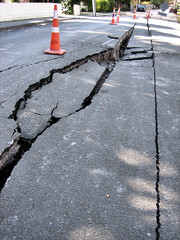
Search
Images for damaged roads; more images...
Ferry Road Shops
Images, eqnz.chch.2010
Pws-2010-09-29-dsc02899
Ferry Road Shops
Images, eqnz.chch.2010
PWS-2010-09-29-DSC02887
Ferry Road Shops
Images, eqnz.chch.2010
PWS-2010-09-29-DSC02884
Ferry Road Shops
Images, eqnz.chch.2010
Pws-2010-09-29-dsc02890
Ferry Road Shops
Images, eqnz.chch.2010
Pws-2010-09-29-dsc02891
Ferry Road Shops
Images, eqnz.chch.2010
Pws-2010-09-29-dsc02888
Ferry Road Shops
Images, eqnz.chch.2010
PWS-2010-09-29-DSC02886
Ferry Road Shops
Images, eqnz.chch.2010
PWS-2010-09-29-DSC02885
Photograph by Eroica Ritchie 011
Images, UC QuakeStudies
Damage to the Westende Jewellers building. The upper storey facade has collapsed, and rubble covers the road. The area has been cordoned off with road cones and police tape, and fire service personnel are inspecting the damage from the basket of a fire engine's ladder.
Photograph by Eroica Ritchie 009
Images, UC QuakeStudies
Damage to the Westende Jewellers building. The upper storey facade has collapsed, and rubble covers the road. The area has been cordoned off with road cones and police tape, and fire service personnel are inspecting the damage from the basket of a fire engine's ladder.
Photograph by Paul Corliss 2661
Images, UC QuakeStudies
A photograph captioned by Paul Corliss, "Tsunami warning signal, Causeway".
BeckerFraserPhotos September 2011 photograph 366
Images, UC QuakeStudies
Photograph captioned by BeckerFraserPhotos, "Gayhurst Road".
Photograph by Paul Corliss 2662
Images, UC QuakeStudies
A photograph captioned by Paul Corliss, "Tsunami warning signal, Causeway".
Photograph by Paul Corliss 2664
Images, UC QuakeStudies
A photograph captioned by Paul Corliss, "Tsunami warning signal, Causeway".
Photograph by Paul Corliss 2665
Images, UC QuakeStudies
A photograph captioned by Paul Corliss, "Tsunami warning signal, Causeway".
Photograph by Paul Corliss 2663
Images, UC QuakeStudies
A photograph captioned by Paul Corliss, "Tsunami warning signal, Causeway".
BeckerFraserPhotos February 2012 photograph 0088
Images, UC QuakeStudies
A photograph of a damaged house. The photograph is captioned by BeckerFraserPhotos, "New Brighton Road".
BeckerFraserPhotos February 2012 photograph 0086
Images, UC QuakeStudies
A photograph of a damaged driveway. The photograph is captioned by BeckerFraserPhotos, "New Brighton Road".
BeckerFraserPhotos February 2012 photograph 0087
Images, UC QuakeStudies
A photograph of a damaged house. The photograph is captioned by BeckerFraserPhotos, "New Brighton Road".
Damage observations following the MW 7.8 2016 Kaikoura earthquake
Research papers, The University of Auckland Library
On 14 November 2016 a magnitude Mw 7.8 earthquake struck the upper South Island of New Zealand with effects also being observed in the capital city, Wellington. The affected area has low population density but is the largest wine production region in New Zealand and also hosts the main national highway and railway routes connecting the country’s three largest cities of Auckland, Wellington and Christchurch, with Marlborough Port in Picton providing connection between the South and North Islands. These transport facilities sustained substantial earthquake related damage, causing major disruptions. Thousands of landslides and multiple new faults were counted in the area. The winery facilities and a large number of commercial buildings and building components (including brick masonry veneers, historic masonry construction, and chimneys), sustained damage due to the strong vertical and horizontal acceleration. Presented herein are field observations undertaken the day immediately after the earthquake, with the aim to document earthquake damage and assess access to the affected area.
Christchurch Press Image: Carys Monteath, 2011:02:23 07:27:58
Images, UC QuakeStudies
Photograph captioned by Fairfax, "Damage from the February 22nd earthquake in Christchurch. 158 Dyers Pass Road, roof tiles damaged".
Christchurch Press Image: Carys Monteath, 2011:02:23 07:28:01
Images, UC QuakeStudies
Photograph captioned by Fairfax, "Damage from the February 22nd earthquake in Christchurch. 158 Dyers Pass Road, roof tiles damaged".
Christchurch Press Image: Carys Monteath, 2011:02:23 07:21:35
Images, UC QuakeStudies
Photograph captioned by Fairfax, "Damage from the February 22nd earthquake in Christchurch. 30 Dyer Pass Road, Cashmere - house damage".
Christchurch Press Image: Carys Monteath, 2011:02:23 07:27:33
Images, UC QuakeStudies
Photograph captioned by Fairfax, "Damage from the February 22nd earthquake in Christchurch. 158 Dyers Pass Road, roof tiles damaged".
Christchurch Press Image: Carys Monteath, 2011:02:23 07:21:06
Images, UC QuakeStudies
Photograph captioned by Fairfax, "Damage from the February 22nd earthquake in Christchurch. 30 Dyers Pass Road, Cashmere. House damage".
BeckerFraserPhotos December 2011 photograph 1371
Images, UC QuakeStudies
A photograph of damaged houses, captioned by BeckerFraserPhotos, "Earthquake-damage to 99A and 97A Bexley Road".
Earthquake damage in Christchurch
Images, eqnz.chch.2010
A common scene around Christchurch, following the 7.1 magnitude earthquake that hit the city on Saturday September 4, 2010 at around 4:33am. The shake left many roads cracked, buildings demolished, and flooding in the streets.
BeckerFraserPhotos December 2011 photograph 1872
Images, UC QuakeStudies
A photograph captioned by BeckerFraserPhotos, "Earthquake damage to Lois Place, photographed from River Road".
BeckerFraserPhotos February 2011 photograph 262
Images, UC QuakeStudies
Damage to a footpath on Bracken Street in Avonside.
BeckerFraserPhotos February 2011 photograph 265
Images, UC QuakeStudies
Damage to a footpath on Bracken Street in Avonside.



